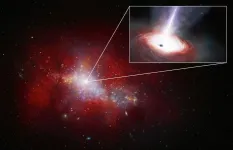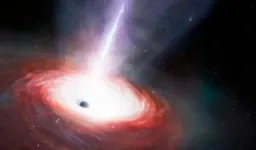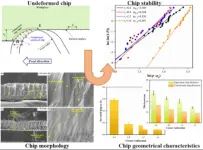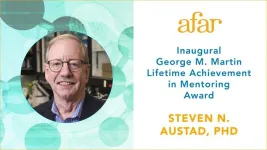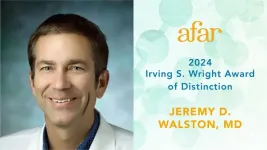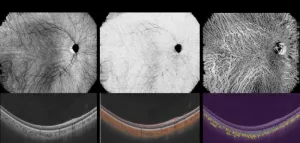(Press-News.org) Supermassive black holes exist at the center of most galaxies, and modern telescopes continue to observe them at surprisingly early times in the Universe’s evolution. It’s difficult to understand how these black holes were able to grow so big so rapidly. But with the discovery of a low-mass supermassive black hole feasting on material at an extreme rate, seen just 1.5 billion years after the Big Bang, astronomers now have valuable new insights into the mechanisms of rapidly growing black holes in the early Universe.
LID-568 was discovered by a cross-institutional team of astronomers led by International Gemini Observatory/NSF NOIRLab astronomer Hyewon Suh. They used the James Webb Space Telescope (JWST) to observe a sample of galaxies from the Chandra X-ray Observatory’s COSMOS legacy survey. This population of galaxies is very bright in the X-ray part of the spectrum, but are invisible in the optical and near-infrared. JWST’s unique infrared sensitivity allows it to detect these faint counterpart emissions.
LID-568 stood out within the sample for its intense X-ray emission, but its exact position could not be determined from the X-ray observations alone, raising concerns about properly centering the target in JWST’s field of view. So, rather than using traditional slit spectroscopy, JWST’s instrumentation support scientists suggested that Suh’s team use the integral field spectrograph on JWST’s NIRSpec. This instrument can get a spectrum for each pixel in the instrument’s field of view rather than being limited to a narrow slice.
“Owing to its faint nature, the detection of LID-568 would be impossible without JWST. Using the integral field spectrograph was innovative and necessary for getting our observation,” says Emanuele Farina, International Gemini Observatory/NSF NOIRLab astronomer and co-author of the paper appearing in Nature Astronomy.
JWST’s NIRSpec allowed the team to get a full view of their target and its surrounding region, leading to the unexpected discovery of powerful outflows of gas around the central black hole. The speed and size of these outflows led the team to infer that a substantial fraction of the mass growth of LID-568 may have occurred in a single episode of rapid accretion. “This serendipitous result added a new dimension to our understanding of the system and opened up exciting avenues for investigation,” says Suh.
In a stunning discovery, Suh and her team found that LID-568 appears to be feeding on matter at a rate 40 times its Eddington limit. This limit relates to the maximum luminosity that a black hole can achieve, as well as how fast it can absorb matter, such that its inward gravitational force and outward pressure generated from the heat of the compressed, infalling matter remain in balance. When LID-568’s luminosity was calculated to be so much higher than theoretically possible, the team knew they had something remarkable in their data.
“This black hole is having a feast,” says International Gemini Observatory/NSF NOIRLab astronomer and co-author Julia Scharwächter. “This extreme case shows that a fast-feeding mechanism above the Eddington limit is one of the possible explanations for why we see these very heavy black holes so early in the Universe.”
These results provide new insights into the formation of supermassive black holes from smaller black hole ‘seeds’, which current theories suggest arise either from the death of the Universe’s first stars (light seeds) or the direct collapse of gas clouds (heavy seeds). Until now, these theories lacked observational confirmation. “The discovery of a super-Eddington accreting black hole suggests that a significant portion of mass growth can occur during a single episode of rapid feeding, regardless of whether the black hole originated from a light or heavy seed,” says Suh.
The discovery of LID-568 also shows that it’s possible for a black hole to exceed its Eddington limit, and provides the first opportunity for astronomers to study how this happens. It’s possible that the powerful outflows observed in LID-568 may be acting as a release valve for the excess energy generated by the extreme accretion, preventing the system from becoming too unstable. To further investigate the mechanisms at play, the team is planning follow-up observations with JWST.
More information
This research was presented in a paper entitled “A super-Eddington-accreting black hole ~1.5 Gyr after the Big Bang observed with JWST” to appear in Nature Astronomy. DOI: 10.1038/s41550-024-02402-9
The team is composed of Hyewon Suh (International Gemini Observatory/NSF NOIRLab, USA), Julia Scharwächter (International Gemini Observatory/NSF NOIRLab, USA), Emanuele Paolo Farina (International Gemini Observatory/NSF NOIRLab, USA), Federica Loiacono (INAF – Astrophysics and Space Science Observatory, Italy), Giorgio Lanzuisi (INAF – Astrophysics and Space Science Observatory, Italy), Günther Hasinger (Institute of Nuclear and Particle Physics/DESY/German Center for Astrophysics, Germany), Stefano Marchesi (INAF-Astrophysics and Space Science Observatory, Italy), Mar Mezcua (Institute of Space Sciences/Institute of Spatial Studies of Catalonia, Spain), Roberto Decarli (INAF – Astrophysics and Space Science Observatory, Italy), Brian C. Lemaux (International Gemini Observatory/NSF NOIRLab, USA, Institute of Astrophysics, Italy), Marta Volonteri (Paris Institute of Astrophysics, France), Francesca Civano (NASA Goddard Space Flight Center, USA), Sukyoung K. Yi (Department of Astronomy and Yonsei University Observatory, Republic of Korea), San Han (Department of Astronomy and Yonsei University Observatory, Republic of Korea), Mark Rawlings (International Gemini Observatory/NSF NOIRLab, USA), Denise Hung (International Gemini Observatory/NSF NOIRLab, USA)
NSF NOIRLab (U.S. National Science Foundation National Optical-Infrared Astronomy Research Laboratory), the U.S. center for ground-based optical-infrared astronomy, operates the International Gemini Observatory (a facility of NSF, NRC–Canada, ANID–Chile, MCTIC–Brazil, MINCyT–Argentina, and KASI–Republic of Korea), Kitt Peak National Observatory (KPNO), Cerro Tololo Inter-American Observatory (CTIO), the Community Science and Data Center (CSDC), and Vera C. Rubin Observatory (operated in cooperation with the Department of Energy’s SLAC National Accelerator Laboratory). It is managed by the Association of Universities for Research in Astronomy (AURA) under a cooperative agreement with NSF and is headquartered in Tucson, Arizona. The astronomical community is honored to have the opportunity to conduct astronomical research on I’oligam Du’ag (Kitt Peak) in Arizona, on Maunakea in Hawai‘i, and on Cerro Tololo and Cerro Pachón in Chile. We recognize and acknowledge the very significant cultural role and reverence that these sites have to the Tohono O’odham Nation, to the Native Hawaiian community, and to the local communities in Chile, respectively.
Links
Read the paper
JWST website
Check out other NOIRLab Science Releases END
NSF NOIRLab astronomers discover the fastest-feeding black hole in the early universe
NSF NOIRLab Astronomers Discover the Fastest-Feeding Black Hole in the Early Universe — Observations from JWST and Chandra reveal a low-mass supermassive black hole that appears to be consuming matter at over 40 times the theoretical limit
2024-11-04
ELSE PRESS RELEASES FROM THIS DATE:
Translational science reviews—a new JAMA review
2024-11-04
About The Article: To help clinicians keep up with ongoing basic and translational science discoveries that affect the diagnosis and treatment of human disease, JAMA has launched a new series, “Translational Science Reviews.” These new article types are succinct and informative summaries of important basic science advances that are transforming diagnosis and treatment of human disease.
Corresponding Author: To contact the corresponding author, Mary M. McDermott, MD, email mdm608@northwestern.edu.
To access the embargoed study: Visit our For The Media website at this link https://media.jamanetwork.com/
(doi:10.1001/jama.2024.21146)
Editor’s Note: Please ...
How the keto diet could one day treat autoimmune disorders
2024-11-04
Scientists have long suspected the keto diet might be able to calm an overactive immune system and help some people with diseases like multiple sclerosis.
Now, they have reason to believe it could be true.
Scientists at UC San Francisco have discovered that the diet makes the gut and its microbes produce two factors that attenuated symptoms of MS in mice.
If the study translates to humans, it points toward a new way of treating MS and other autoimmune disorders with supplements.
The keto diet severely restricts carbohydrate-rich ...
Influence of tool corner radius on chip geometrical characteristics of machining Zr-based bulk metallic glass
2024-11-04
Different from traditional alloys, BMGs exhibit a unique atomic arrangement characterized by short-range order and long-range disorder at the atomic level. Such atomic structure leads to the absence of defects such as grain boundaries and dislocations, resulting in exceptional mechanical properties. The promising properties of BMGs have rapidly positioned them as a new class of structural and functional materials, showing great application potential in various fields including structural, energy and chemical engineering. In order to facilitate their engineering applications, research has reported their cutting characteristics from various aspects, ...
Megan Huisingh-Scheetz, MD, MPH, of the University of Chicago recognized with AFAR’s Terrie Fox Wetle Rising Star Award in Health Services and Aging Research
2024-11-04
New York, NY – The American Federation for Aging Research (AFAR), is proud to recognize the outstanding contributions of Megan Huisingh-Scheetz, MD, MPH, with the 2024 Terrie Fox Wetle Rising Star Award in Health Services and AgingResearch.
This award honors a health services researcher in an early or middle phase of his/her career who has already made importantcontributions with work that respects the value of multidisciplinary health services science and that ...
Steven N. Austad, PhD, to receive inaugural George M. Martin Lifetime Achievement in Mentoring Award
2024-11-04
New York, NY–The American Federation for Aging Research (AFAR) is pleased to announce the recipient of the inaugural George M. Martin Lifetime Achievement in Mentoring Award: Steven N. Austad, PhD, Protective Life Endowed Chair in Healthy Aging Research and a Distinguished Professor in the Department of Biology at the University of Alabama at Birmingham (UAB).
The Award is named in honor of George M. Martin, MD (1927-2022), a pioneer in the field of aging research and AFAR’s Scientific Director for more than a decade. A Professor of Pathology at the University of Washington, Dr. Martin devoted his long, distinguished career to growing the field of aging ...
Jeremy D. Walston, MD, of Johns Hopkins University to receive AFAR 2024 Irving S. Wright Award of Distinction
2024-11-04
New York, NY – The American Federation for Aging Research (AFAR), is pleased to recognize the exemplary contributions of Jeremy D. Walston, MD, to the field of aging research through the 2024 Irving S. Wright Award of Distinction. This award is named in honor of AFAR’s founder and recognizes exceptional contributions to basic or clinical research in the field of aging. Established in 1982, the award is a framed citation and carries a cash prize of $5,000.
Dr. Walston, the Raymond and Anna Lublin Professor of Geriatric Medicine at Johns Hopkins University (JHU), holds multiple leadership roles at JHU, including Director of the Human Aging Project, ...
SwRI receives $23 million in U.S. Air Force contracts to sustain aging aircraft
2024-11-04
SAN ANTONIO — November 4, 2024 —Southwest Research Institute has received two contracts totaling $23 million from the U.S. Air Force for a program to address aging aircraft structures and material degradation. Under these contracts, the Institute will help the Air Force modernize methods to sustain the T-38 Talon, the A-10 Thunderbolt and the B-52 Stratofortress. All three military aircraft first came into service more than 45 years ago.
“SwRI will assist with the full spectrum of structural sustainment for these aircraft,” said Luciano Smith, manager of SwRI’s Structural Integrity Group. “Our analyses will help the Air Force know ...
Insilico Medicine enters into revolving loan facility of up to US$100 Million with HSBC
2024-11-04
Insilico Medicine(“Insilico”), a global leading generative artificial intelligence (AI)-driven biotechnology company, today announced it has signed a Revolving Loan Facility of up to US$100 million with HSBC, one of the world's largest banks and financial services institutions. HSBC’s customized financing solution will support Insilico’s global development centered on multiple sites, as well as the expansion of innovative advantages, thus driving the economy growth in the Greater Bay Area.
Insilico is committed to driving advancements in healthcare using cutting-edge AI technology, reducing costs and improving efficiency in early-stage ...
Security in quantum computing
2024-11-04
Alongside artificial intelligence, quantum computing is one of the fastest-growing subsets in the high-performance computing community. But what happens when this relatively new and powerful computing method reaches the limit of the cyberinfrastructure and network security capabilities of today?
Researchers at the National Center for Supercomputing Applications are addressing this issue before it becomes a problem.
“The problem is urgent because practical quantum computers will break classical encryption in the next decade,” ...
Noninvasive choroidal vessel analysis via deep learning: A new approach to choroidal optical coherence tomography angiography
2024-11-04
Researchers from Peking University have developed a novel noninvasive choroidal angiography method that enables layer-wise visualization and evaluation of choroidal vessels using deep learning. This new approach, published in Health Data Science, employs an advanced segmentation model that can handle varying quality of optical coherence tomography (OCT) B-scans, making it a promising tool for clinical applications in diagnosing retinal diseases.
Choroidal Optical Coherence Tomography Angiography (C-OCTA) offers a significant improvement in the analysis of choroidal vessels, a critical component in the ...
LAST 30 PRESS RELEASES:
How talking slows eye movements behind the wheel
The Ceramic Society of Japan’s Oxoate Ceramics Research Association launches new international book project
Heart-brain connection: international study reveals the role of the vagus nerve in keeping the heart young
Researchers identify Rb1 as a predictive biomarker for a new therapeutic strategy in some breast cancers
Survey reveals ethical gaps slowing AI adoption in pediatric surgery
Stimulant ADHD medications work differently than thought
AI overestimates how smart people are, according to HSE economists
HSE researchers create genome-wide map of quadruplexes
Scientists boost cell "powerhouses" to burn more calories
Automatic label checking: The missing step in making reliable medical AI
Low daily alcohol intake linked to 50% heightened mouth cancer risk in India
American Meteorological Society announces Rick Spinrad as 2026 President-Elect
Biomass-based carbon capture spotlighted in newly released global climate webinar recording
Illuminating invisible nano pollutants: advanced bioimaging tracks the full journey of emerging nanoscale contaminants in living systems
How does age affect recovery from spinal cord injury?
Novel AI tool offers prognosis for patients with head and neck cancer
Fathers’ microplastic exposure tied to their children’s metabolic problems
Research validates laboratory model for studying high-grade serous ovarian cancer
SIR 2026 delivers transformative breakthroughs in minimally invasive medicine to improve patient care
Stem Cell Reports most downloaded papers of 2025 highlight the breadth and impact of stem cell research
Oxford-led study estimates NHS spends around 3% of its primary and secondary care budget on the health impacts of heat and cold in England
A researcher’s long quest leads to a smart composite breakthrough
Urban wild bees act as “microbial sensors” of city health.
New study finds where you live affects recovery after a hip fracture
Forecasting the impact of fully automated vehicle adoption on US road traffic injuries
Alcohol-related hospitalizations from 2016 to 2022
Semaglutide and hospitalizations in patients with obesity and established cardiovascular disease
Researchers ‘listen in’ to embryo-mother interactions during implantation using a culture system replicating the womb lining
How changing your diet could help save the world
How to make AI truly scalable and reliable for real-time traffic assignment?
[Press-News.org] NSF NOIRLab astronomers discover the fastest-feeding black hole in the early universeNSF NOIRLab Astronomers Discover the Fastest-Feeding Black Hole in the Early Universe — Observations from JWST and Chandra reveal a low-mass supermassive black hole that appears to be consuming matter at over 40 times the theoretical limit
